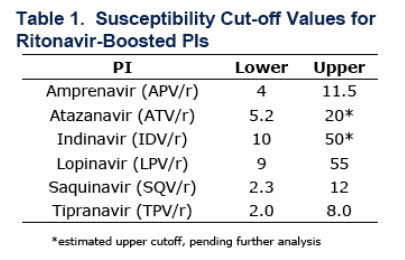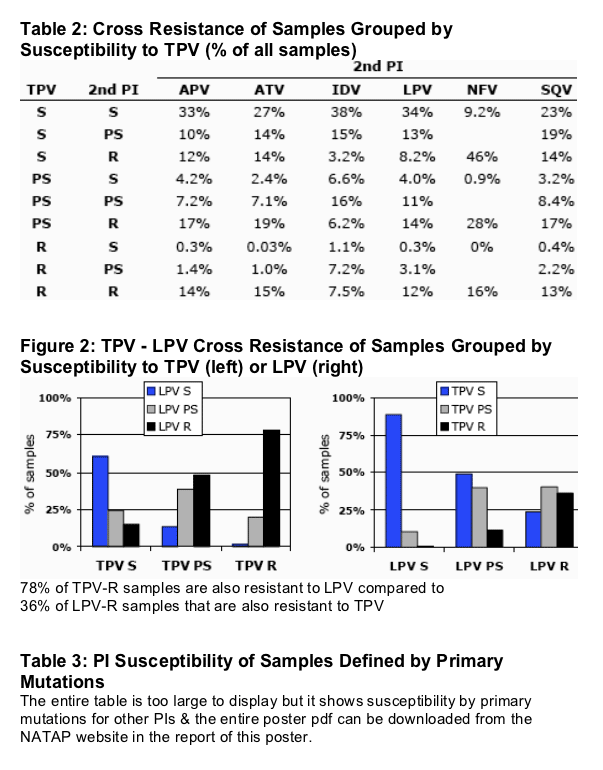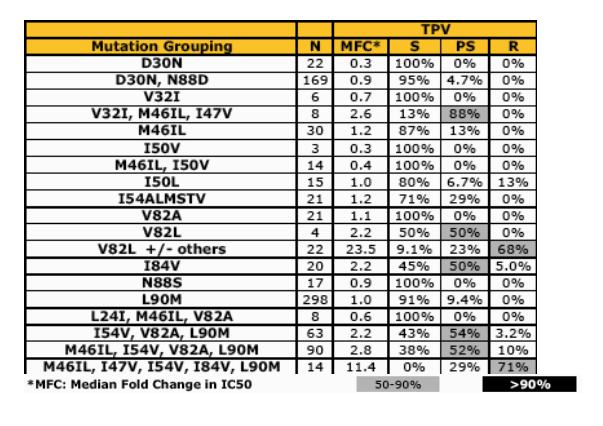 |
 |
 |
| |
Patterns of Tipranavir Susceptibility and Cross-Resistance Among Patient Samples Submitted for Routine Resistance Testing
|
| |
| |
Download the poster this article is based on in PDF format
Reported by Jules Levin
NT Parkin, C Chappey, and E Coakley
Monogram Biosciences, South San Francisco CA USA.
Poster 30
XV International HIV Drug Resistance Workshop
Sitges, Spain, June 13-17, 2006
BACKGROUND
- Tipranavir, the most recently approved protease inhibitor (PI) (before TMC114 was approved), has a favorable activity profile among viruses resistant to other PIs.
- However the relative degree of cross-resistance between tipranavir and other PIs and in samples containing mutation clusters selected by other PIs is not fully understood.
METHODS
- The prevalence and patterns of tipranavir resistance and PI cross-resistance was characterized within a database containing phenotype (PhenoSense HIV) and genotype (GeneSeq HIV) results for 3564 samples containing at least
one PI-selected mutation, submitted to the Monogram Clinical Reference Laboratory for routine resistance testing.
- PI-selected mutations were defined as any non-wild type amino acid at position 23, 24, 30, 32, 46, 47, 48, 50, 54, 82 (except V82I), 84, 88, and 90.
- Samples with mixtures at major resistance-associated positions were removed.
- Only one sample per patient was included if repeats were present.
- Samples with extreme resistance too high to measure (IC50 higher than the maximum concentration tested in the assay) were assigned a drug-specific "Max FC" value for calculation purposes
- Samples were classified as tipranavir sensitive (S), partially sensitive (PS), or resistant (R) if the fold change in IC50 (FC) was less than the lower cut-off, between the lower and upper cut-off, or over the upper cut-off, respectively (see Table 1). For nelfinavir, the biological cut-off (3.6) was used to define samples as sensitive or having reduced susceptibility.

RESULTS SUMMARY
- In the complete data set, 55.6%, 28.6%, and 15.8% of samples were susceptible, partially susceptible, or resistant to TPV/r, respectively.
- Linear regression coefficients (R2) using log-transformed FC values between TPV and other PIs ranged between 0.27 - 0.40. For comparative purposes, the R2 value for LPV vs. IDV is 0.75 (Figure 1).
- Among samples PS to TPV/r, the percentage susceptible to other PIs was 14% for APV/r, 8% for ATV/r, 23% for IDV/r, 14% for LPV/r, 3% for NFV, 11% for SQV/r.
- Of samples PS to LPV, the percentage susceptible to other PIs was 26% for APV/r, 16% for ATV/r, 34% for IDV/r, 3% for NFV, 17% for SQV/r, 49% for TPV/r.
- The median FC (MFC) to TPV was less than 2 in samples containing only one primary PI mutation except V82L (MFC 2.4, n=4); the percentage of samples that were PS to TPV was over 25% for I84V and V82L (Table 3).
- TPV MFC was elevated (2.1 to 2.8) in samples with the following mutation combinations: V32I/M46IL/I47V, I54V/V82A/L90M, and M46IL/I54V/V82A/L90M (n=5, 85, and 56, respectively). In these 3 groups, approximately 60-90% of samples had at least partial TPV resistance, but fewer than 10% were fully resistant (Table 3).
CONCLUSIONS
- Cross resistance between TPV and other approved PIs is lowest with NFV and SQV, highest with APV and ATV, but modest in any case.
- Viruses with single primary mutations remain largely sensitive to TPV, with the exception of I84V and V82L.


|
| |
|
 |
 |
|
|